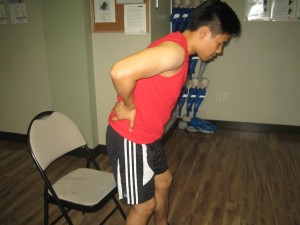Tailbone pain or coccygodynia can result from trauma or a fall onto the base part of the spine. In such circumstances, it can lead to the bruising of the periosteum, thus resulting to pain. Falls onto the tailbone can also fracture the bone or dislocate it at the sacroccygeal joint which is where the sacrum and coccyx come together or both.
Depending on the result of the trauma, providing relief for tailbone pain is often a difficult task. In reality, since sitting is a regular activity for most of us, it directly impacts the coccyx. This leads to discomfort when the individual has tailbone pain and can disrupt the quality of life.
What are the symptoms of tailbone pain?
The symptoms of tailbone pain include pain and discomfort at the base of the spine. In some cases, it can also include pain in the lower back and/or hips. The individual might even experience shooting pain down the legs.

The intensity of the pain varies from one individual to another. As for the severity of the pain, it can worsen over time. Coccygodynia can disrupt the lifestyle of the individual. It can disturb a good night’s rest and interfere with the ability to perform activities while sitting and/or bending. Remember that when weight is placed on the coccyx bone, even if the surface beneath it has a soft chair or pillow, the pain will likely increase. In addition, getting up from a seated position can be hard.
How tailbone pain is diagnosed
The doctor will diagnose tailbone pain by taking a medical history, physical examination and testing. In most cases, the doctor will ask the individual to sit and/or perform some cycling in an attempt to reproduce the symptoms.
Treatment for tailbone pain
Remember that it is not easy to achieve pain relief for tailbone pain. Just like with most spinal issues, the treatment includes conservative measures and surgical intervention. The surgery for tailbone pain is known as coccygetectomy which can be partial or full removal of the tailbone. Generally, the results of surgery tend to be moderate at best but it also puts the individual at risk for complications.
As for the conservative treatment, it includes rest, medications such as NSAIDs, using a cushion with a hole in the center, physical therapy and acupuncture. Once the individual is in the chronic stage of the injury, physical therapy might include hands-on techniques to increase the flexibility of the pelvic floor which releases the coccyx bone in case it is stuck.
The doctor suggests a steroid injection or an injection of a local anesthetic to help manage the pain. Oftentimes, a pain control technique called as radiofrequency ablation is utilized for tailbone pain, but this is not generally recommended.
According to experts, most cases of tailbone pain can achieve the best results after undergoing a number of treatments, instead of just one treatment option.
